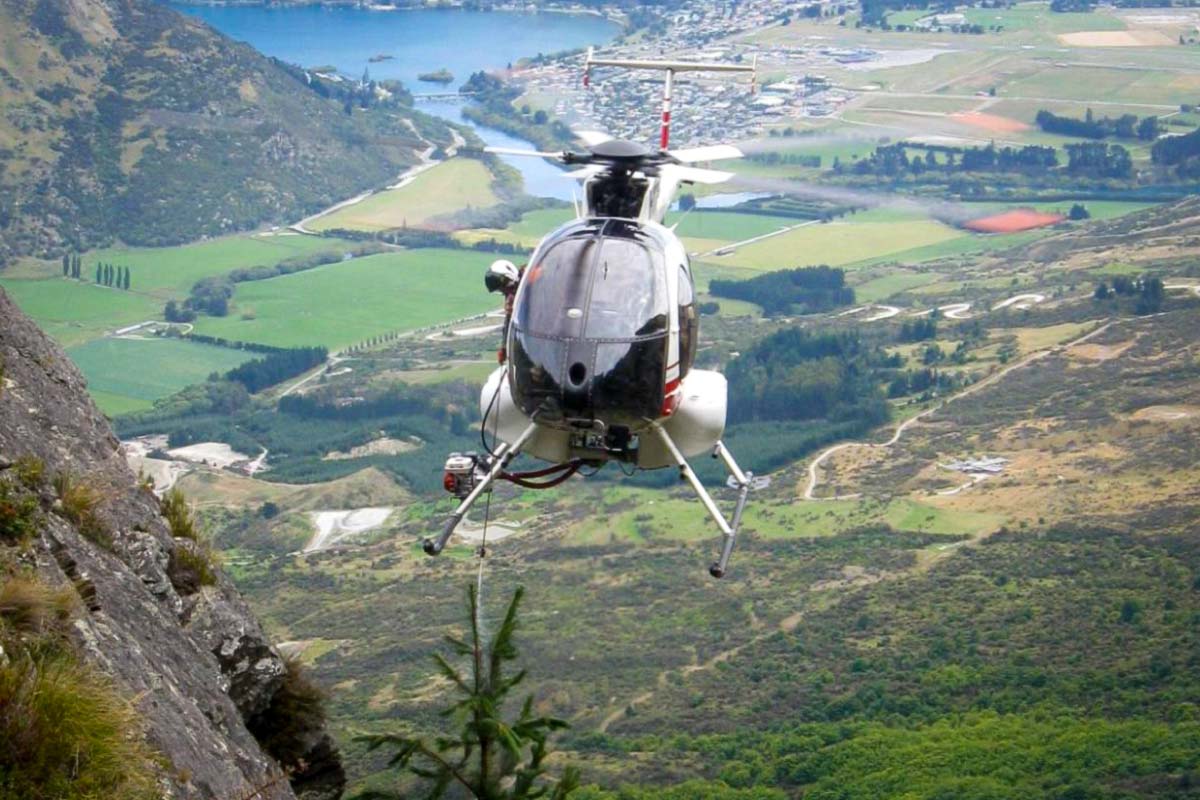WCG oversee a commercial operational control plan for the Whakatipu. This plan employs a range of contractors and control methods, including helicopter boom spraying, Aerial Basal Bark Application (lancing), logging where feasible, arborists and chainsaw ground crews.
All trees are GPS marked before removal and added to the extensive Whakatipu and National mapping programme, this mapping of current and historical control helps to shape future priority work.
The National Wilding Conifer Control Programme researches control methods and develops guidelines for best practice. These summarise standards expected for safe wilding conifer control.
Cut Stump Ground Control
Cut stump is a control method that involves cutting a tree down and applying herbicide to the cut stump to prevent regrowth. It is suitable for the control of trees which are accessible from the ground and where the risk of damage to surrounding vegetation is minimal or not a concern.


Ground-Based Herbicide Injection – Drill and Fill
Drill & Fill can be a very cost-effective method where trees have a trunk diameter of over 10cm and are accessible to ground crews.
- Rather than cutting down large trees, it is often better to drill holes into a tree’s trunk and fill the holes with herbicide.
- This is a good option on difficult terrain where felling is unsafe.
ABBA Aerial Basal Bark Application (Lancing or Wanding)
Lancing is a type of Aerial spot spraying used to treat individual trees/noxious weeds by using “Basal Bark mixture” applied by hand using the helicopter as an operational platform to ‘Chemically Ringbark’ tree trunks in a manner that wets the complete circumference of the trunk or lower stems. Most trees controlled in this way are small, and the “chemical ringbark” action is applied directly to the stem only and not the whole foliage, the release height above the tree is a matter of centimetres hence the overall herbicide use is more accurate and considerably lower volumes than what most public perceive about Aerial spraying. Spray drift from this product and application method is extremely low. A passenger crew person inside the helicopter sits holding the “lance” and applies the herbicide, as the helicopter is piloted in a hover directly over the plant.
- The ABBA method of wilding conifer control is targeted and involves chemically ring-barking trees by using a wand to apply herbicide from a helicopter.
- The ABBA method is particularly useful for widely scattered trees, inaccessible or unsafe areas (such as steep slopes) and in sensitive areas where specific targeting of wilding conifers is required amongst desirable vegetation or public assets.
- Dead trees are left standing until they naturally rot away. It is the most efficient way to control scattered wildings in difficult-access areas or within high-value vegetation.


Aerial Foliar Spray Application: (Boom spraying)
As a last resort in dense and inaccessible wilding stands, helicopters are used to deliver herbicides known as Aerial Foliar Spray Application (AFSA).
- AFSA is only used in ideal conditions to ensure the operation is precise and well away from waterways.
- AFSA Boom Spraying is a cost-effective approach that treats large dense infestations. It is best used where there is minimal risk of damage to nearby vegetation.
- Over time, the dead trees will decompose into the soil, with beech forest and golden tussock grasslands prevailing.
Logging Operations
A commonly asked question is why isn’t the WCG harvesting the wildings and using the money from sales to defray the costs of control?
The answer is we will do this where we can but it is not always economic, or even possible. Wildings are not managed in the way trees in a commercial forest are. Managed trees are pruned and thinned to produce marketable timber for a range of uses, including construction.
Wildings on the other hand grow according to a range of factors such as access to water, nutrients, climatic conditions and so on. Their timber is often not suitable for any commercial purpose.
Large quantities of wind-blown wilding seed can produce a proliferation of wildings in one location. Douglas-fir wildings like those on Bob’s Peak grow haphazardly wherever they germinate. Here, they are often tall and spindly as they compete for their share of light and space.
Because wildings often grow in places that are not suitable for commercial forests, harvesting is not planned from the outset. Wildings growing in the back country or in otherwise hard-to-access places can only be retrieved at great cost after felling, making it massively uneconomic.
Surely wildings can be sold for firewood?
Unfortunately even easily accessible wildings do not always fetch prices for firewood which cover the cost of felling. Sometimes we will still sell the wilding logs to firewood merchants and take a loss on the cost of felling where it is necessary to clear a site.


